Affiliate links on Android Authority may earn us a commission. Learn more.
Samsung Galaxy S10 review: Finding the middle ground is hard
October 1, 2021
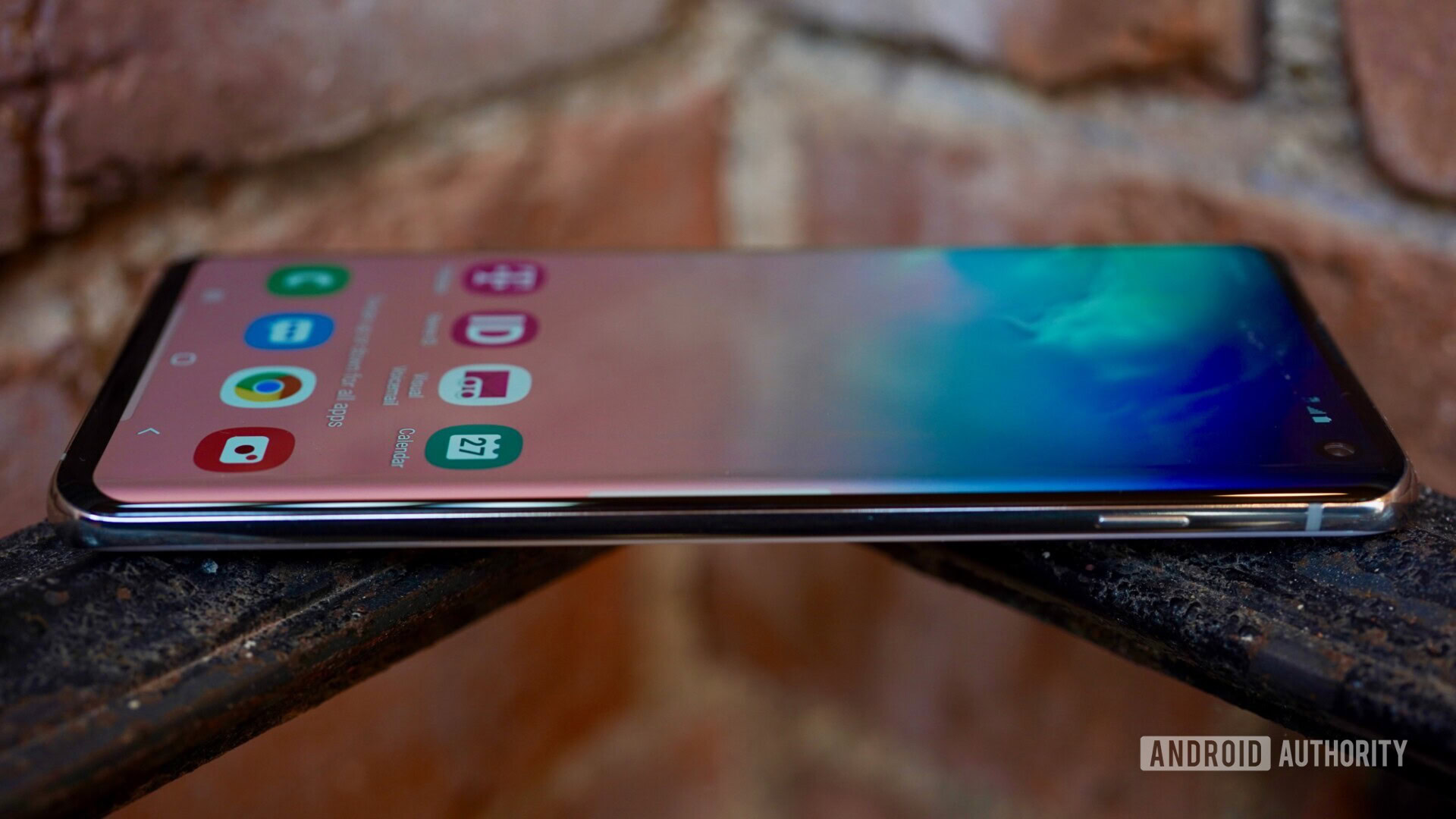
The Samsung Galaxy S10, the middle child of the company’s flagship series, is a fantastic phone that might easily be lost in the shuffle. Where the Galaxy S10 Plus has been lauded for its large screen and capable battery, and the Galaxy S10e for its compact form and ease-of-use, the S10 is challenged to strike the proper balance in between.
Samsung is in an enviable position. With three phones to choose from, it’s more likely to capture a purchase by those seeking an Android over iPhone. Find out what — if anything — sets the S10 apart.
Read more: Here’s everything new in Samsung One UI 3.0
Here is Android Authority‘s Samsung Galaxy S10 review.
Samsung Galaxy S10 review: The big picture
The equation for calculating which device is best for any given person is a complicated one at best. In simplest terms, it requires finding the right set of features at a price the person is willing to pay.
In its 2019 Galaxy S lineup, Samsung mirrored the strategy unveiled by Apple late last year. Where Apple offers iPhones for $749, $999 and $1,099, Samsung now, too, offers high-end phones for $749, $899, and $999. By covering a wider range of price points, Samsung has given itself a better chance of resolving the equation for a greater number of people.
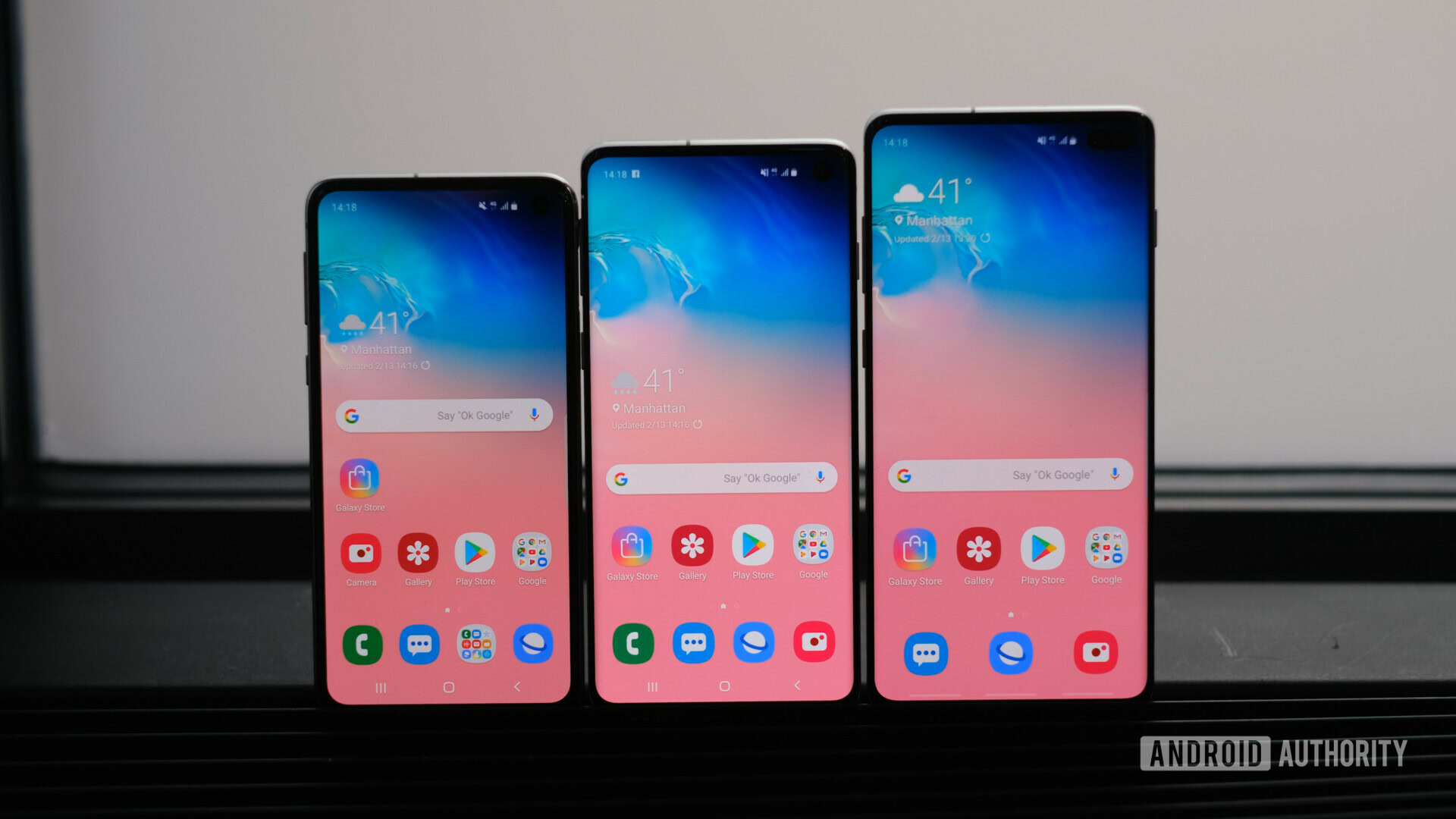
At $649 (or more, if you upgrade the storage), the Galaxy S10 has a lot of competition from its own siblings, let alone the market as a whole. Did Samsung tweak the S10 in just the right ways to score with consumers? We’re here to tell you.
Design
- Aluminum chassis
- Gorilla Glass 6
- Nano SIM / MicroSD memory card
- 150 x 70 x 7.8 mm
- 157g
- 3.5mm headphone jack
- Fingerprint reader (under display)
- Black, Blue, Pink, White
- IP68
- USB-C
Samsung is the class leader when it comes to hardware. It improves its phones every year, at least incrementally, and this year sees a pleasing evolution in design when compared to last year’s Galaxy S9. The S10 is still metal and glass, and yet it feels more approachable to me.
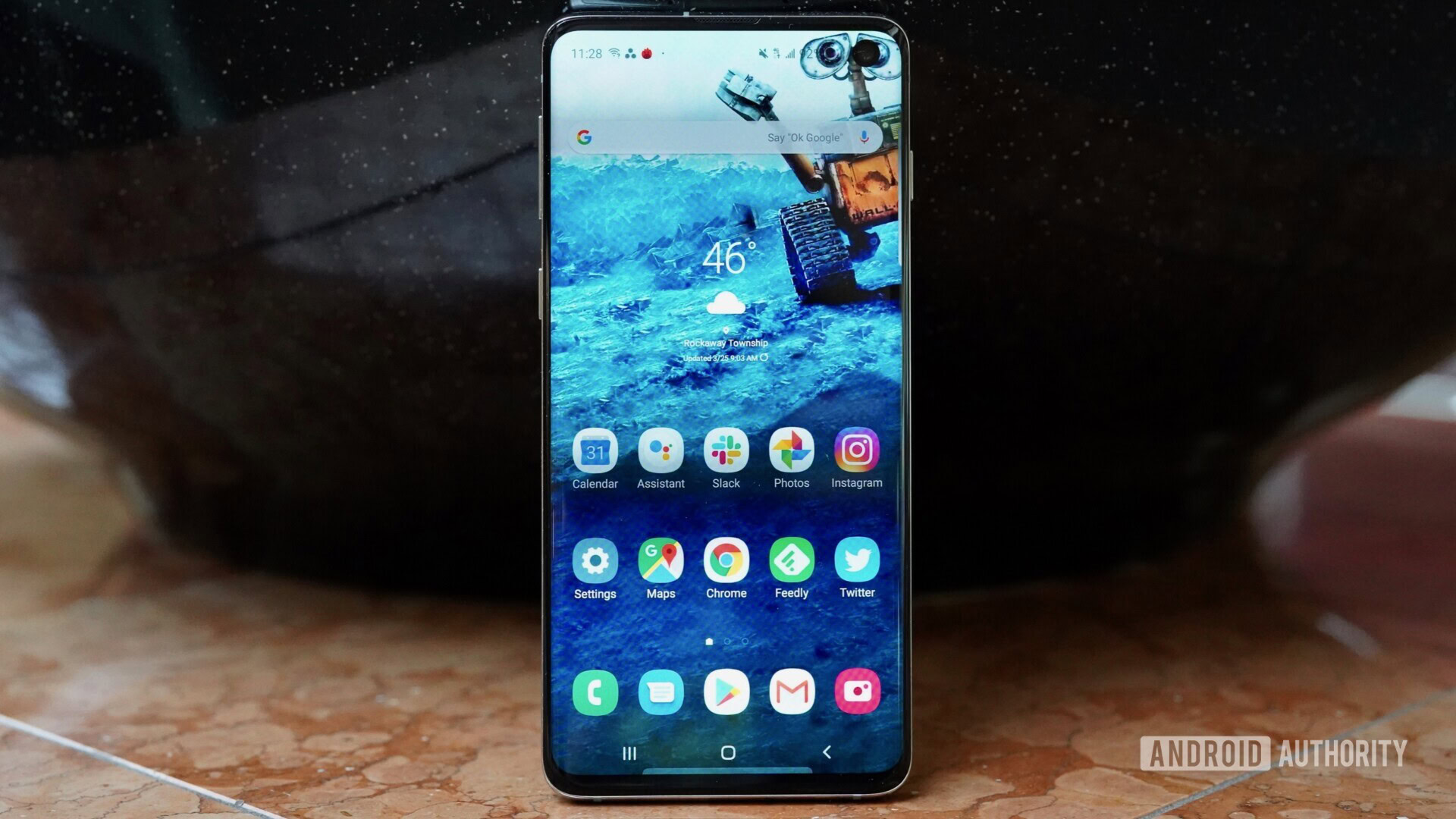
The curves of the front and back glass surfaces are spot on and merge with the metal frame flawlessly. Samsung smoothed over the feel of the side edges, which came across as somewhat sharp on the S8 and S9. The frame swells a bit in thickness on the top and bottom edges, lending strength to the phone. Since the S10 is one of the first phones to ship with Gorilla Glass 6, we don’t yet have real-world data on just how shatterproof it is. Like all glass phones, I felt nervous using the S10 when walking down city streets or standing over tile or cement floors. Gorilla Glass is still glass after all.
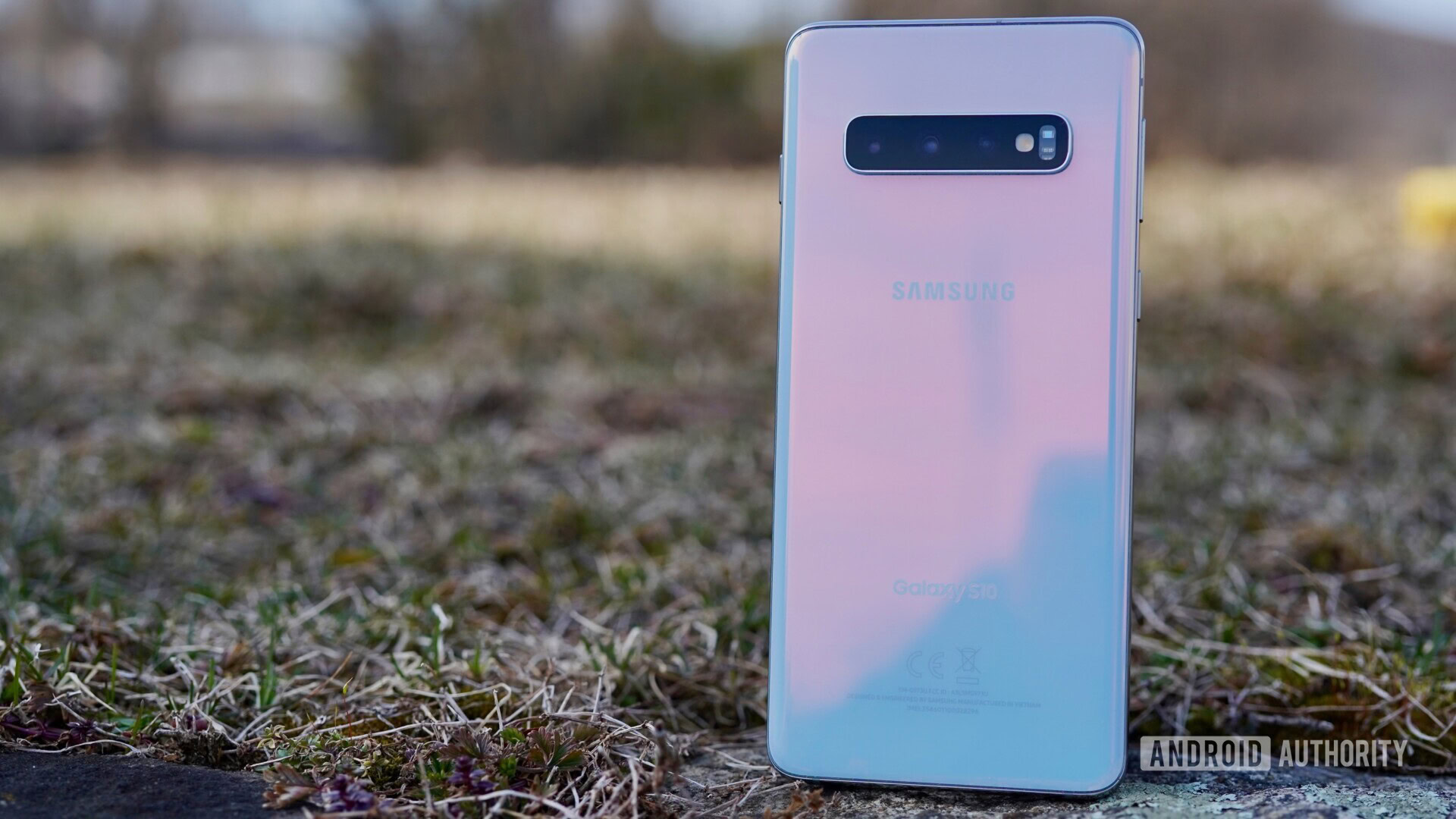
The most important “feature” of the S10 is its size. It’s a bit bigger than the S10e and a bit smaller than the S10 Plus. It’s also a smidge smaller than competing devices such as the HUAWEI Mate 20 Pro, LG G8, and OnePlus 6T. In other words, if you shy away from mega-huge handsets, but still want all of the best specs, the S10 fits that mix. This goes double for folks who have smaller hands.
I used the phone without a case and came away pleased by the form factor. It disappeared comfortably in my pocket and was a breeze to use one-handed. I generally prefer phones with larger screens, but the punch hole display has allowed Samsung to put ever-bigger screens on ever-smaller devices.
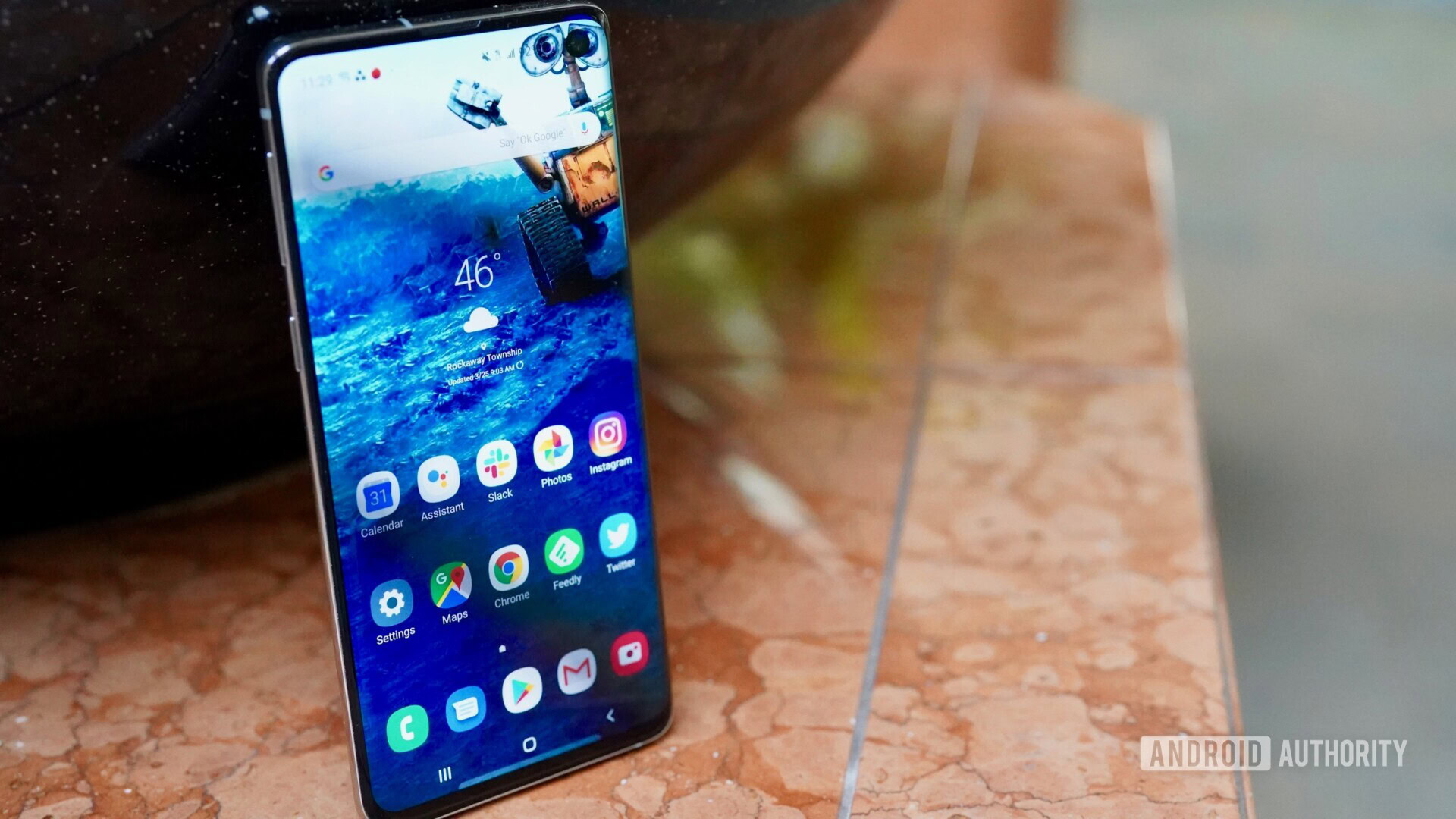
All the buttons and ports do their job. I’m happy to see the 3.5mm headphone jack on the bottom of the phone, where it is easier to access. The controversial Bixby button on the left edge can, for the first time, be rerouted to other apps (except Google Assistant and Amazon Alexa.) That’s a major improvement — and a tacit admission from Samsung that its original thinking was not in line with consumer preferences. The buttons themselves deliver perfect, crisp action.
The camera array is gigantic. It stretches 1.75 inches across the back glass in a raised rectangular module. The module is black no matter the color of the rest of the handset. In addition to the three cameras and flash, the module also contains the heart rate sensor.
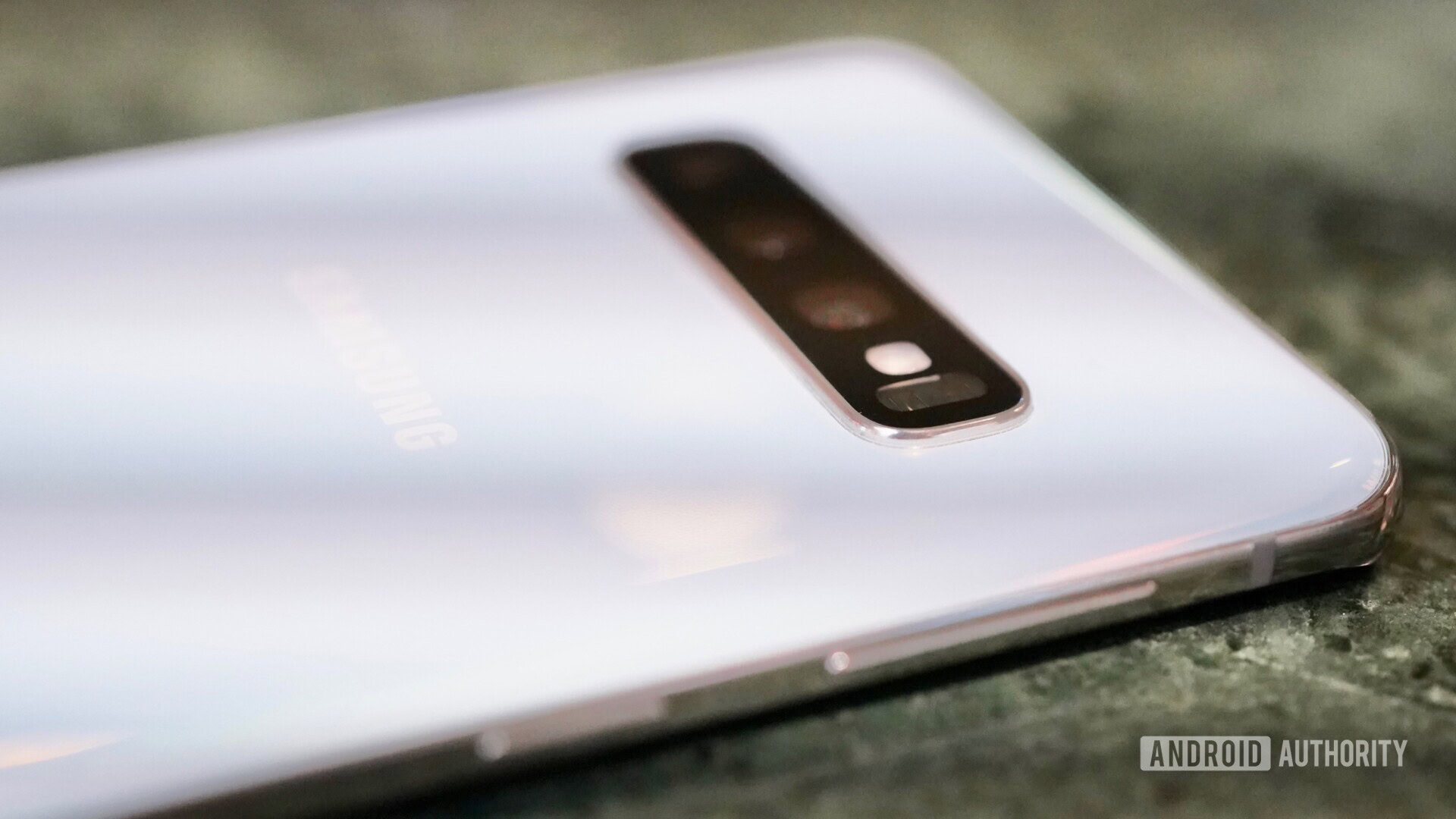
I checked to make sure the phone is waterproof, and the IP68 rating holds up. The S10 shook off a shower like a wet dog.
The Samsung Galaxy S10 may not necessarily be perfect for me, but it is perfect for someone.
Display
- 6.1-inch Quad HD+ Super AMOLED
- 3,040 by 1,440 pixels with 551ppi
- 19:9 aspect ratio
- Single selfie cutout
When Samsung first introduced the S10, it said three core pillars drove it forward: display, camera, and performance. Samsung’s focus has paid off.
Simply put, the S10 has one of the best displays I’ve ever seen. It’s a stunner top to bottom. Samsung’s Super AMOLED tech has always been impressive and the latest iteration thereof is simply fantastic.
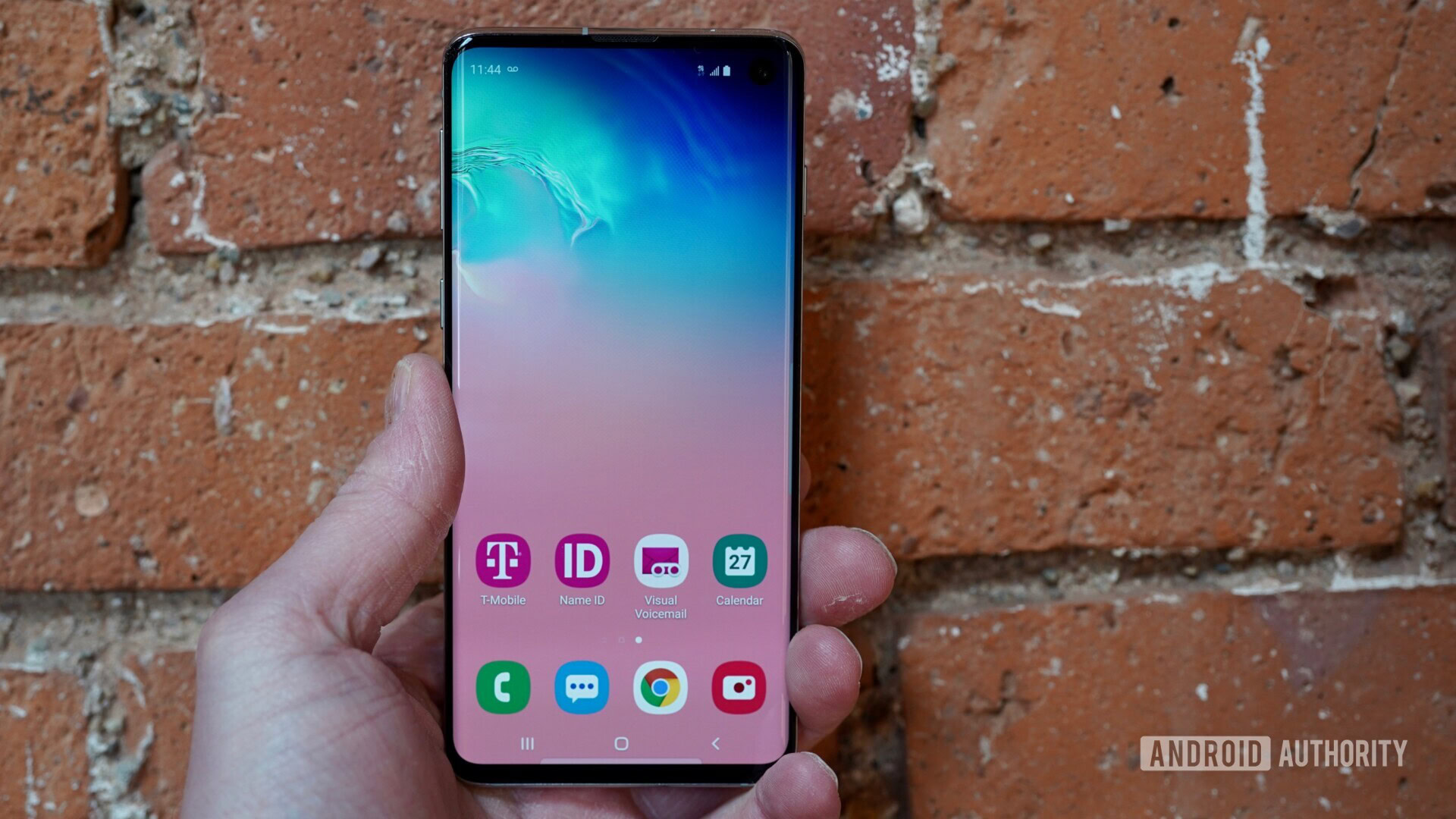
Samsung says the S10’s screen makes use of Dynamic OLED technology. It combines blue light reduction and brightness control in a way that reduces eye strain by 42%. The HDR10+ offers lots of brightness and contrast. This means everything looks amazing. Colors are more accurate and viewing high-definition content from Netflix and other providers impresses.
The S10 does allow for alternative viewing experiences. For example, it ships set to natural color, but users can opt for vivid if they wish. The vivid setting makes colors stand out just a bit more. If you select vivid, you’ll also be allowed to tweak the white balance, and even the levels of red, green, blue saturation. The S10 includes night mode for those who prefer darker backgrounds. As always, you can adjust the resolution (high, medium, low), the size of icons, and the size of text to suit your needs.
The screen has a hole in it.
The screen has a hole in it. Samsung calls this the Inifinty-O Display. The cut out is a small circle positioned in the upper right corner of the glass. The ambient light and proximity sensors are buried under the display. This allowed Samsung to extend the screen up toward the top edge of the phone and achieve a display ratio of 93.1%. In other words, the S10 offers as close to an “all-screen” experience as we’ve seen. I haven’t decided if I like the notch or the hole more. The only time I really notice the hole is when viewing full-screen video, and then it is grating.
The fingerprint reader, which is buried under the display, is not so great. In-screen readers are the latest trend among flagship phones. We’ve seen them on the HUAWEI Mate 20 Pro, the OnePlus 6T, and more recently the Nokia 9. None of these implementations has been up to par, in my book, but the S10’s is more usable than the Nokia 9 or Mate 20 Pro’s.
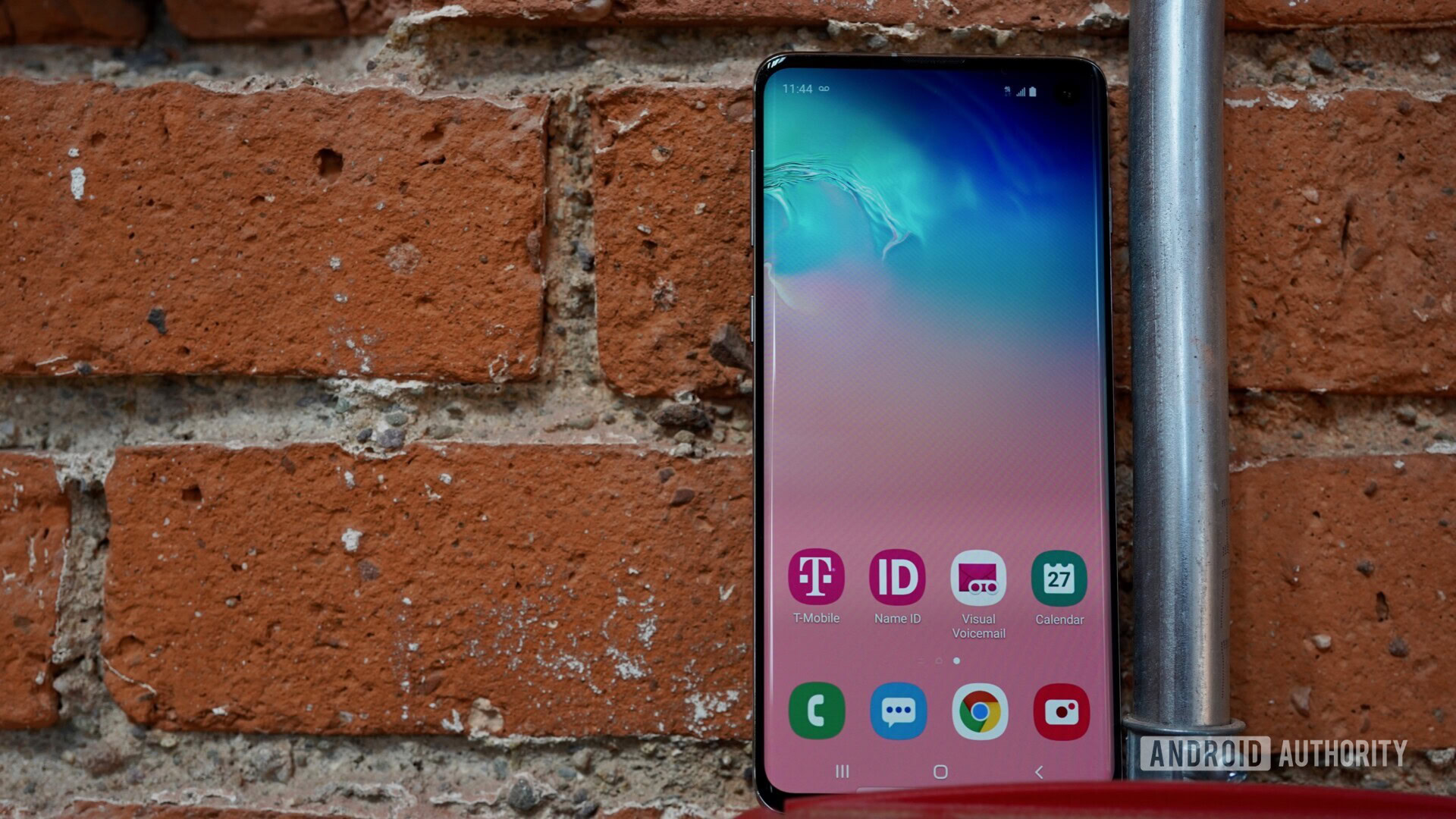
To start, it’s an ultrasonic fingerprint scanner. Rather than take a picture of your print, it makes a 3D scan of the contours on your finger. This protects against spoofing. Samsung says the fingerprint data is stored in the Knox Trust Zone on the device, making it safe from hackers. I have no misgivings about the security. It’s the performance that’s the problem.
Like most others, the under-the-glass reader is easy to train. No issues there. It’s mostly about speed. The reader is just not fast enough. You need to place your thumb just right and hold it for a second. The process of finding the right place, touching/holding, etc., lasts only a few seconds, but feels like an eternity when you have to quickly answer an urgent message. By way of comparison, the traditional fingerprint reader on the rear of the Galaxy Note 9 is easy to find by feel and unlocks the phone in an instant.
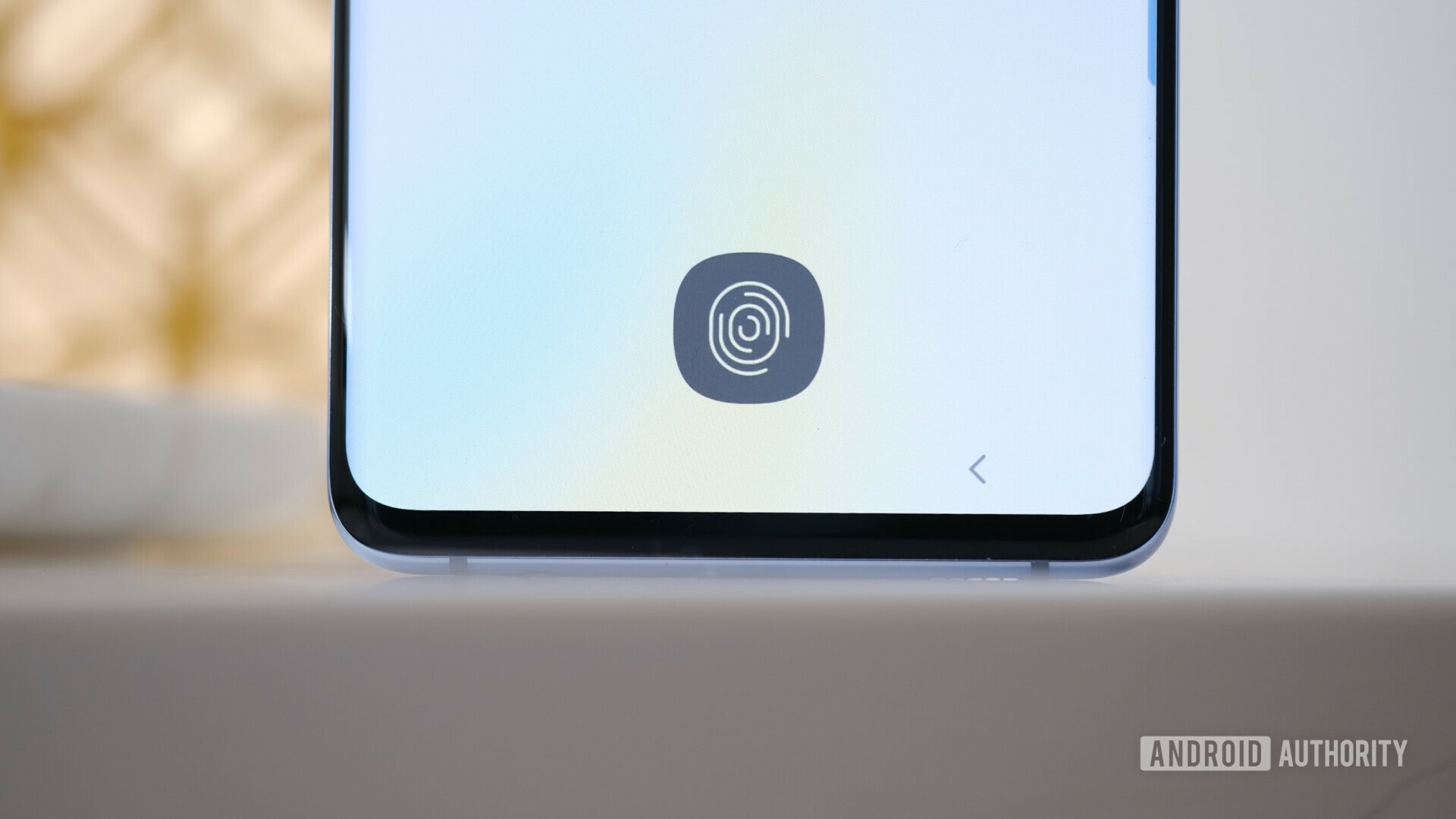
Equally frustrating, Samsung says the fingerprint scanner is not compatible with all third-party screen protectors. It is working with accessory makers to ensure that compatible screen protectors are certified and clearly labeled as such. Thankfully, the phone ships with a screen protector pre-applied.
Performance
- Snapdragon 855
- 2.8GHz octa-core, 7nm process
- 8GB RAM
- 128GB storage
The S10 is among the first to ship with the Snapdragon 855, the top-of-the-line chip from Qualcomm. All the base Galaxy S10 devices include a minimum 8GB of RAM, which is stellar.
It should come as no surprise that the S10 crushed the usual trio of benchmarks. It scored 5,641/4,831 on the 3DMark Sling Shot Extreme for OpenGL ES and Vulkan, respectively. That’s better than 90 percent of competing devices. Similarly, it amassed an impressive 354718 in GeekBench. This score bested 90 percent of other phones, as well. Last, for AnTuTu the S10 churned out 3,423 / 10,340 for single- and multi-core tests, respectively.
After an initial hiccup that necessitated a factory reset, we’ve seen nothing but excellent performance from the Galaxy S10.
Battery
- 3,400mAh Lithium ion
- Qualcomm Quick Charge 2.0
- Qi wireless charging
- Wireless PowerShare
After using our Samsung Galaxy S10 review unit, we’re confident most people should find that the phone delivers a full day of battery life with some room to spare.
I took the phone on a road trip and didn’t once run into an issue with battery life, despite lots of photography, tethering, and other battery-intensive tasks. On days that I used the phone from 8am to 11pm or later, it typically had between 15 percent and 20 percent remaining at the end of the day. That’s not a lot, but it is just enough.
Wireless PowerShare is more gimmick than gimme.
Samsung provides plenty of control over how the phone draws power. The easiest way will be to select the power mode that best matches your needs at the time. The phone ships in optimized mode, which balances performance and battery life. You can jump to high performance for gaming, or dial back to medium power saving mode or maximum power saving mode when you need to conserve power.
All of these modes do impact battery life. When I switched to medium power savings mode, for example, I noticed the phone had more like 35 percent left at the end of the day rather than 15 percent. That’s hours of additional usage and the difference between being able to hail an Uber late at night or walking home.
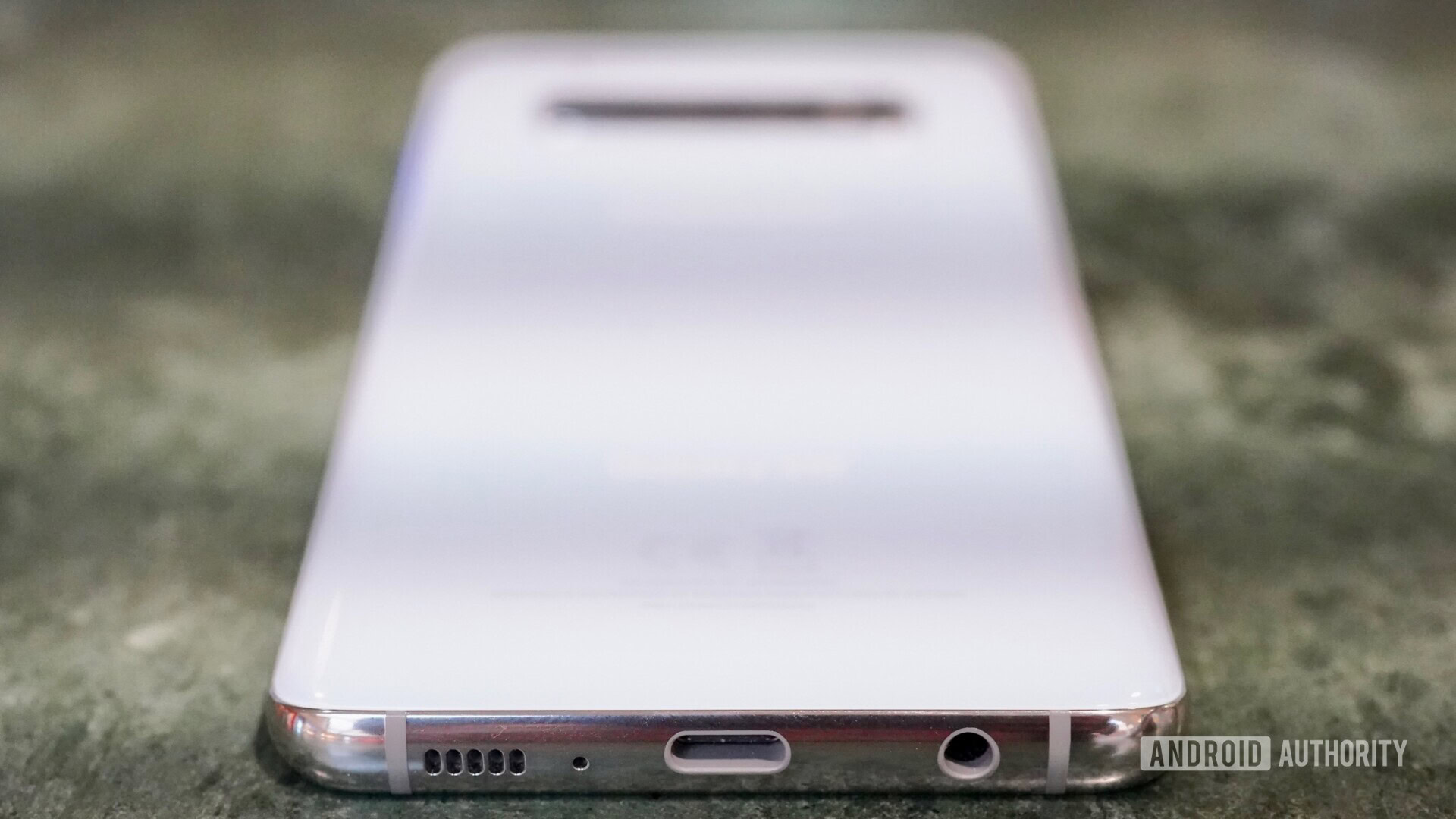
The S10 charges rapidly. Whether used with the included charger or a high-wattage wireless charger, the S10 gulps in power.
The Wireless PowerShare feature, wherein the S10 can charge another device, is more gimmick than gimme. I tried to charge a Samsung Galaxy Galaxy S9 on the S10. While the S10 did transfer power to the phone, it did so so slowly that the effort just wasn’t worth it. Of course, PowerShare is really meant for charging accessories more than other handsets, but even then our charging tests indicate it’s not the best experience.
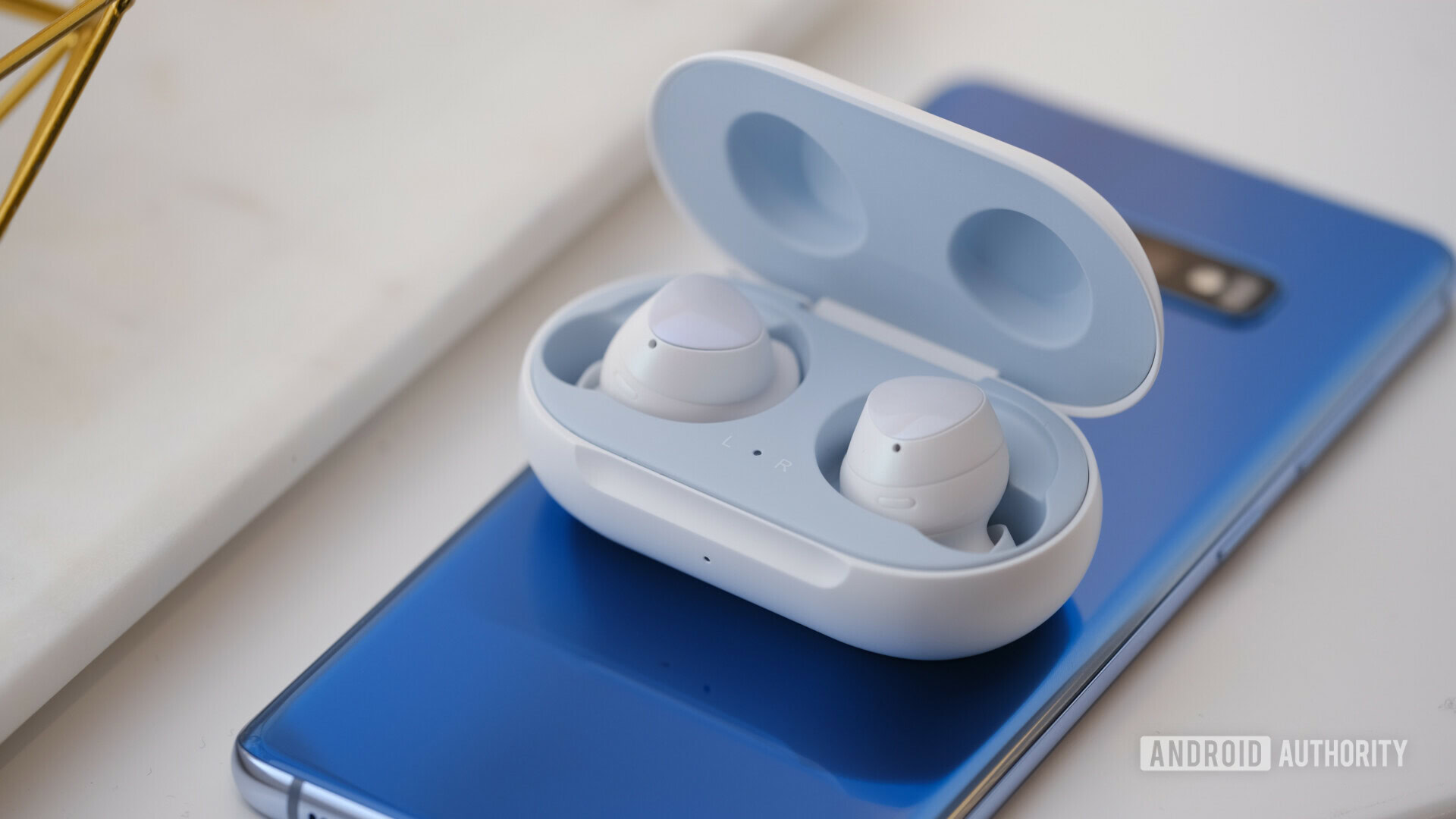
Camera
- Rear cameras:
- 12MP 2x telephoto sensor, autofocus, OIS, 45-degree FoV, ƒ/2.4 aperture
- 12MP wide-angle sensor, autofocus, OIS, 77-degree FoV, dual ƒ/1.5 and ƒ/2.4 apertures
- 16MP ultra-wide sensor, 123-degree FoV, ƒ/2.2 aperture
- Front camera:
- 10MP sensor, autofocus, 80-degree FoV, ƒ/1.9 aperture
Imaging is another major pillar upon which Samsung rests the success of the Galaxy S10 range. Each of the three devices has a slightly different set of cameras. The S10 has three rear cameras and a single front camera. Comparatively, the S10e has two rear cameras and a single front camera, and the S10 Plus has three rear cameras and two front cameras. Confused? Yeah, Samsung didn’t necessarily make this easy to grok at a glance.
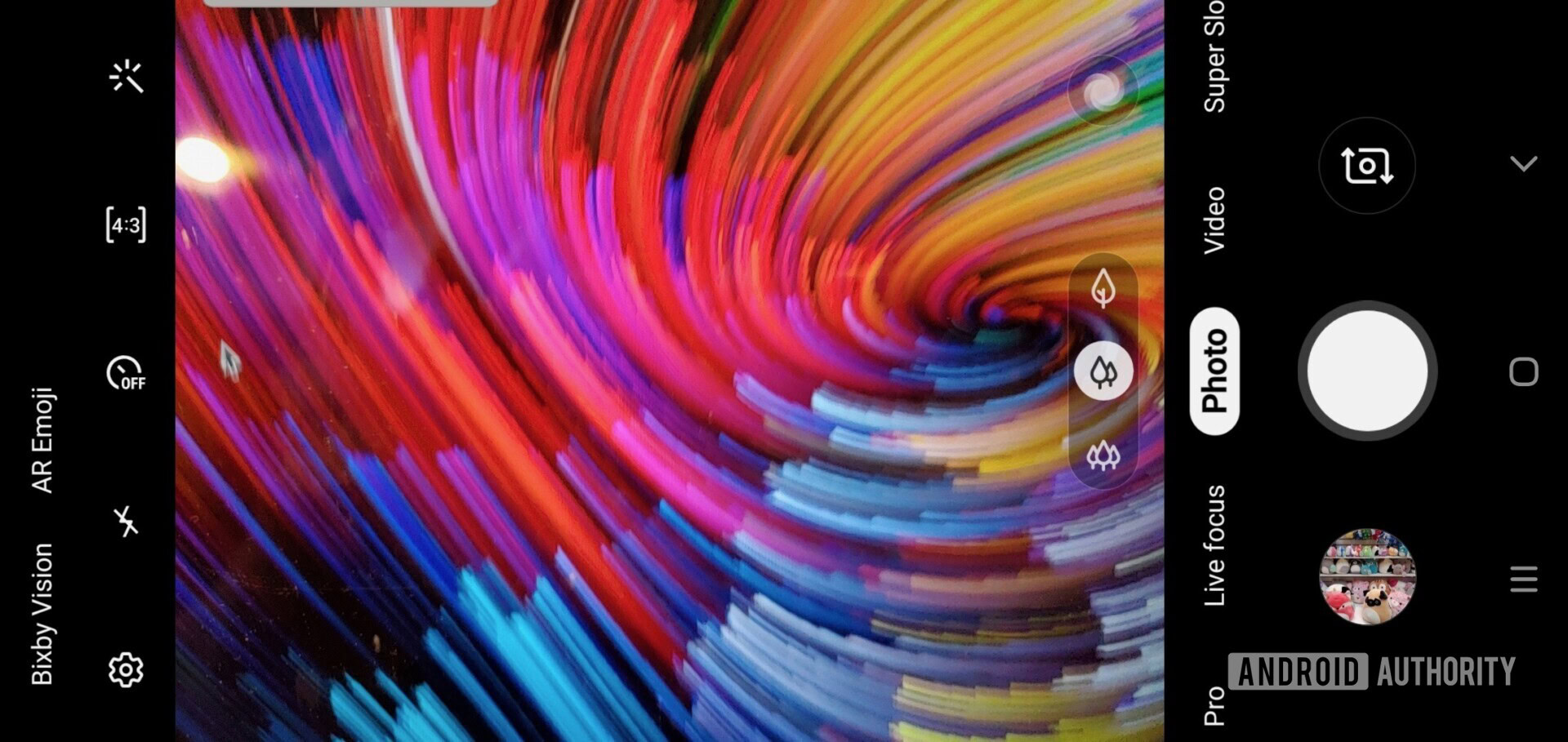
The camera app is more usable than those of previous Galaxy S phones thanks to the OneUI refresh. The controls are laid out in a fashion that makes sense. Buttons line the left edge of the viewfinder and simplify the process of switching aspect ratios, controlling the flash, setting the timer, and accessing the full settings menu. A large shutter button is affixed to the right side.
I’m very happy that Samsung has moved to the three-camera system that LG and HUAWEI have already adopted. It gives you so many more options when taking pics. There’s a standard angle lens for regular stuff, a wide-angle lens for that really big picture, and a 2x optical zoom lens for sharper telephoto shots. This is exactly the creative freedom that I want when shooting pictures (and not necessarily the innovative, but ultimately flawed Nokia 9.) Perhaps most importantly, Samsung has made it dead simple to flip between the three lenses thanks to a simple switch parked next to the shutter button.
Pictures look good -- for the most part.
Core shooting modes include photo, video, live focus, super slow-mo, pro, panorama, food, instagram, slow-mo, and hyperlapse. Switching between modes requires you to swipe the viewfinder in one direction or another. The S10 is able to zoom through the camera app quickly, particularly when jumping between shooting modes. Thank goodness.
I found the modes each worked well. The pro mode lets you adjust a wide number of settings, such as shutter speed, aperture, ISO, brightness, and focus. Photographers who know what they’re doing can put these to creative use.
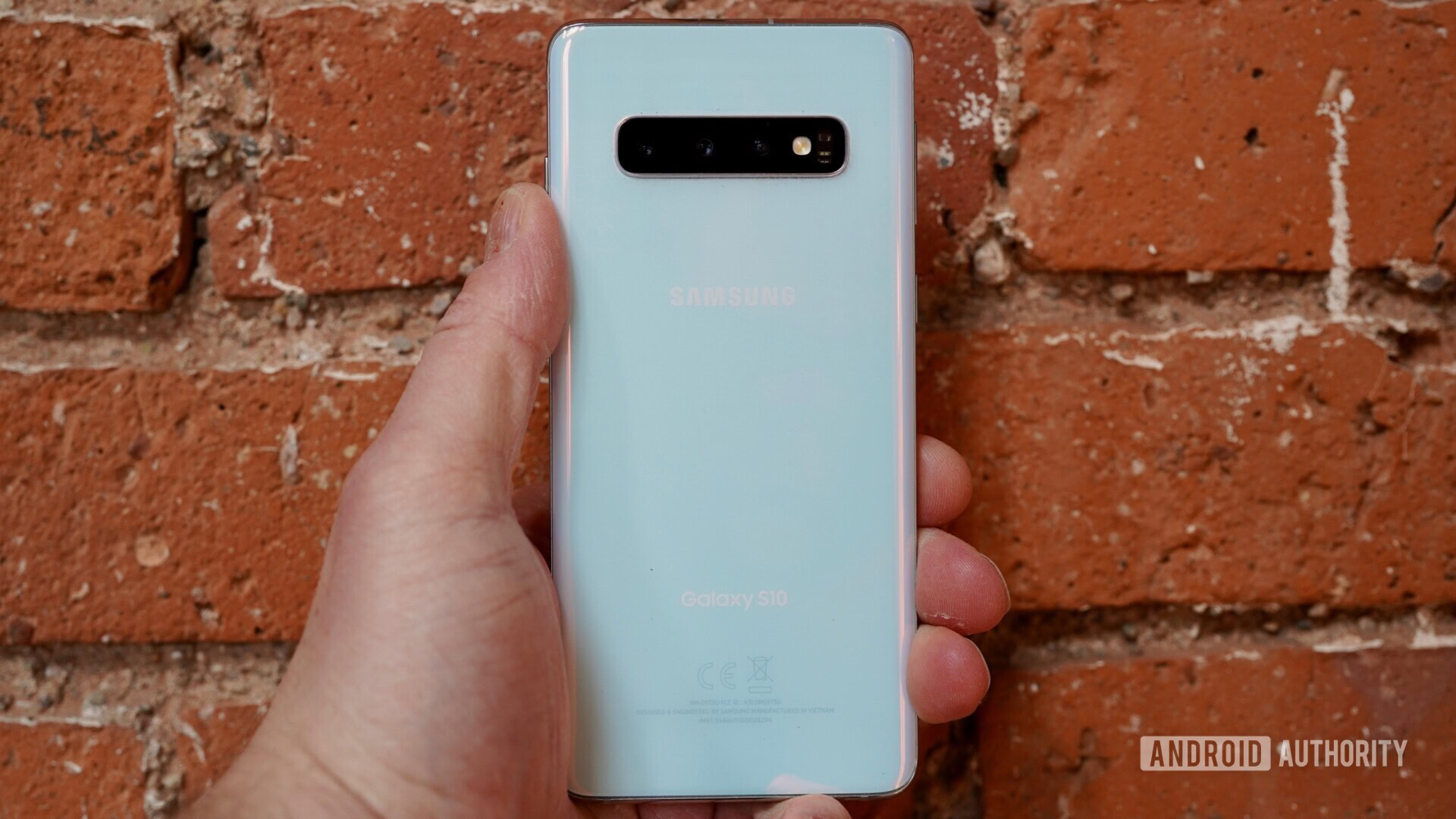
The live focus mode is your bokeh/portrait tool. There are four quick options for selecting the degree of background blur and vignetting that’s applied. This sort of mimics the studio lighting effect available on iPhones, but Samsung didn’t name the options. Alternately, you can use a slider to manually adjust the blur’s intensity. It’s easy enough to use, but I think it could be more obvious to people that this mode is for portraits.
The remaining shooting modes each requires a few minutes to learn properly. Once mastered, they can deliver some fun results.
How do the photos look? Good, for the most part, with some exceptions clouding up the picture.
I was generally happy with exposure and white/color balance. Photos appeared to be balanced properly with respect to bright and dark regions. I saw very little grain in dark shots. Look at the night scenes I captured in LA. They are incredibly clean. White balance is accurate, but color was pushed a bit much for my tastes. This is signature Samsung. I was particularly impressed with the group shot I took at twilight. Look how balanced that exposure is.

Focus is where things start to get fuzzy. Literally. The S10 often delivered soft images, particularly those captured in low-light environments. The worst come from the ultra wide-angle lens. I expected some distortion, and sure enough I noticed bent lines in the corners. We saw similar results from other wide-angle lenses on phones such as the V30 from LG.
The 10MP selfie camera works great when you ignore the portrait tool. Pictures are sharp and well exposed. Switching to the live focus effect gives you all sorts of weird results. You’ll note how inaccurate the border around my head is in the samples below, and how jarring the effect is behind me.
Last up, video. The Galaxy S10 can shoot video up to 4K at various frame rates. I was pleased with the results, which were more consistently good than results from the still camera. Sound captured along with the video is also quite good.
Full-resolution photo samples from the Samsung Galaxy S10 are available here.
Audio
- 3.5mm headphone jack
- Bluetooth 5 with aptX HD
- Stereo speakers
- FM radio
Samsung knows that people are ticked with Apple, Google, and HUAWEI for removing the headphone jacks from their flagship phones. That’s why Samsung made sure the Galaxy S10 has a 3.5mm jack on the bottom edge. You can plug your favorite headphones in, sit back, and enjoy your tunes. The S10 ships with a basic pair of wired earbuds from AKG. They sound decent, but I’d only use them in a pinch.
Stereo speakers should be on every flagship phone, particularly one that’s serious about video. The S10 includes two speakers that provide stereo sound when the phone is tipped on its side. A standard earpiece speaker is at the top of the screen, and a louder speaker graces the bottom edge. This combo delivers a nice sonic punch, whether you’re letting the phone play some music in the background, or watching the latest episode of your favorite show. The sound is loud enough to fill a single room.
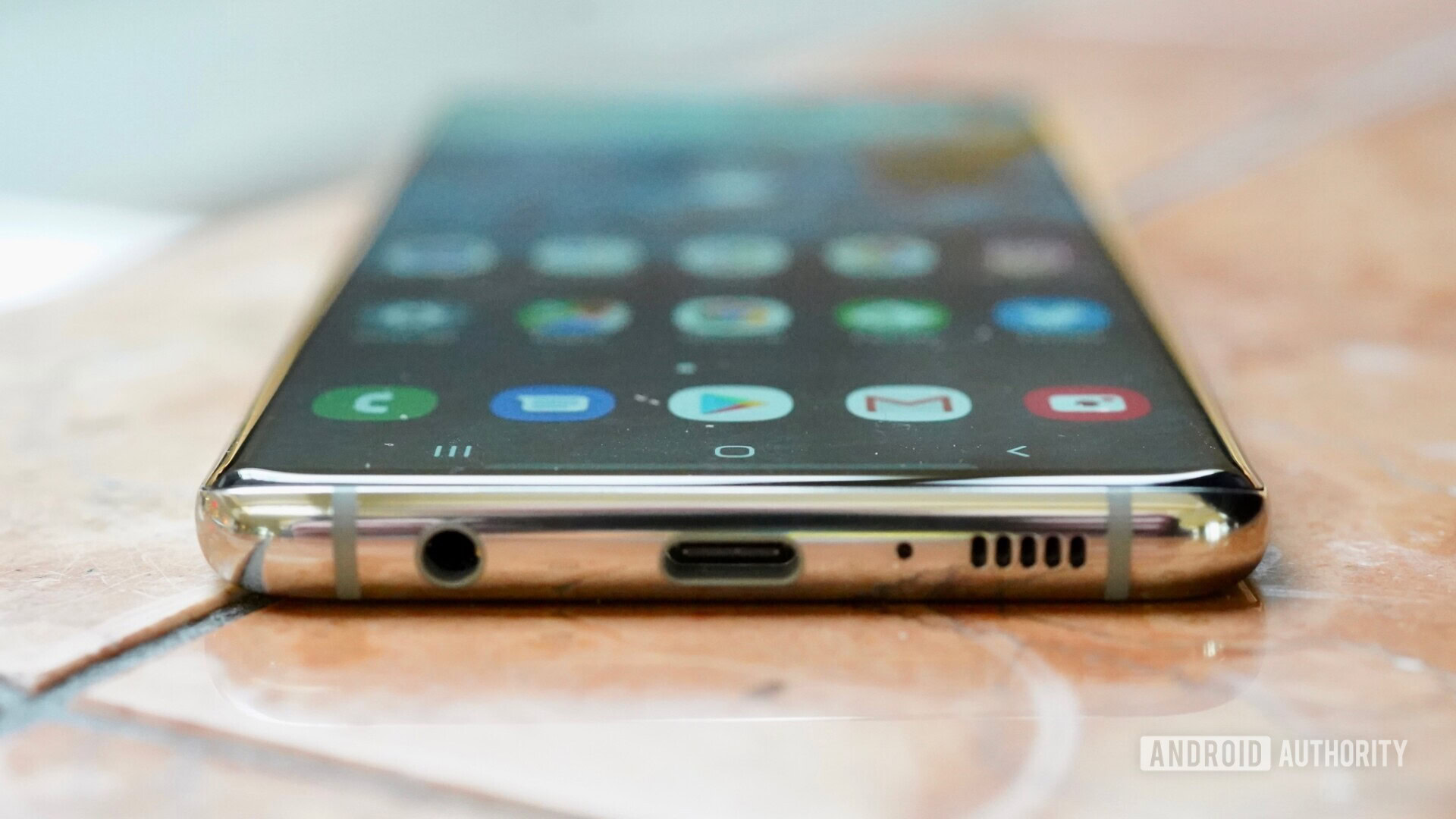
I was impressed with the Bluetooth experience, too. Using my favorite pair of wireless headphones, the aptX HD software delivers clean sound over a stable connection.
Phone calls over T-Mobile’s network sounded excellent.
Software
- Android 9 Pie
- Samsung OneUI v1.1
Samsung’s software experience has been up and down over the years. Late last year it began testing refreshed software called OneUI. The Galaxy S10 family is the first to ship with OneUI, though Samsung has made the software available to older devices such as the S9 and Note 9. It’s a big step up for Samsung.
For one, Samsung tweaked the icons, fonts, and colors just enough so the experience feels different and fresh. The settings menu has been reordered and looks cleaner. I like how the various sections are arranged under fewer subheads. I think I still prefer the look of raw Android, but Samsung’s OneUI is superior to Huawei’s EMUI.
The mechanics of the underlying Android 9 Pie operating system are intact. You can opt from several home screen styles, easily access the Quick Settings/notification shade, and control nearly every facet of the theme. (Yes, you can download wallpapers that highlight and/or hide the punch hole.) It’s mostly fluid as you move through the menus. Samsung kept its Edge Screen tool, which acts like a quick-access panel for certain apps and contacts.
Samsung still insists on foisting Bixby on everyone. A dedicated Bixby button appears on the left edge of the phone and consumes the left-most home screen panel. Samsung has refreshed the look of Bixby and I think it’s better, but the voice assistant’s functionality is still not where it needs to be. Samsung added Bixby Routines, which let you combine certain actions in a manner similar to IFTTT and Siri Shortcuts. The good news is that Samsung is finally allowing people to remap the dedicated button to other apps (with the exception of voice assistants.)
Specs
| Samsung Galaxy S10e | Samsung Galaxy S10 | Samsung Galaxy S10 Plus | |
|---|---|---|---|
Display | Samsung Galaxy S10e 5.8-inch AMOLED panel 2,280 x 1,080 resolution 435ppi 19:9 aspect ratio | Samsung Galaxy S10 6.1-inch AMOLED panel 3,040 x 1,440 resolution 551ppi 19:9 aspect ratio | Samsung Galaxy S10 Plus 6.4-inch AMOLED panel 3,040 x 1,440 resolution 525ppi 19:9 aspect ratio |
Processor | Samsung Galaxy S10e 8nm octa-core Exynos 9820 / 7nm octa-core Snapdragon 855 | Samsung Galaxy S10 8nm octa-core Exynos 9820 / 7nm octa-core Snapdragon 855 | Samsung Galaxy S10 Plus 8nm octa-core Exynos 9820 / 7nm octa-core Snapdragon 855 |
RAM | Samsung Galaxy S10e 6/8GB | Samsung Galaxy S10 8GB | Samsung Galaxy S10 Plus 8/12GB |
Storage | Samsung Galaxy S10e 128/256GB | Samsung Galaxy S10 128/512GB | Samsung Galaxy S10 Plus 128/512GB / 1TB |
MicroSD | Samsung Galaxy S10e Yes, up to 512GB | Samsung Galaxy S10 Yes, up to 512GB | Samsung Galaxy S10 Plus Yes, up to 512GB |
Cameras | Samsung Galaxy S10e Rear: 16MP f/2.2 ultrawide + 12MP f/1.5 and f/2.4 dual pixel with OIS Front: 10MP f/1.9 dual pixel | Samsung Galaxy S10 Rear: 16MP f/2.2 ultrawide + 12MP f/1.5 and f/2.4 dual pixel with OIS + 12MP OIS telephoto f/2.4 Front: 10MP f/1.9 dual pixel | Samsung Galaxy S10 Plus Rear: 16MP f/2.2 ultrawide + 12MP f/1.5 and f/2.4 dual pixel with OIS + 12MP OIS telephoto f/2.4 Front: 10MP f/1.9 dual pixel + 8MP depth sensor f/2.2 |
Battery | Samsung Galaxy S10e 3,100mAh Non-removable | Samsung Galaxy S10 3,400mAh Non-removable | Samsung Galaxy S10 Plus 4,100mAh Non-removable |
Wireless charging | Samsung Galaxy S10e Fast Wireless Charging 2.0 Wireless PowerShare | Samsung Galaxy S10 Fast Wireless Charging 2.0 Wireless PowerShare | Samsung Galaxy S10 Plus Fast Wireless Charging 2.0 Wireless PowerShare |
Water resistance | Samsung Galaxy S10e IP68 | Samsung Galaxy S10 IP68 | Samsung Galaxy S10 Plus IP68 |
Security | Samsung Galaxy S10e Capacitive fingerprint scanner. 2D face unlock. | Samsung Galaxy S10 Embedded Ultrasonic fingerprint scanner. 2D face unlock. | Samsung Galaxy S10 Plus Embedded Ultrasonic fingerprint scanner. 2D face unlock. |
Connectivity | Samsung Galaxy S10e Wi-Fi 6 Bluetooth 5 Cat20 LTE, 7CA, 4x4 MIMO | Samsung Galaxy S10 Wi-Fi 6 Bluetooth 5 Cat20 LTE, 7CA, 4x4 MIMO | Samsung Galaxy S10 Plus Wi-Fi 6 Bluetooth 5 Cat20 LTE, 7CA, 4x4 MIMO |
SIM | Samsung Galaxy S10e Nano SIM | Samsung Galaxy S10 Nano SIM | Samsung Galaxy S10 Plus Nano SIM |
Software | Samsung Galaxy S10e Android 9 Pie | Samsung Galaxy S10 Android 9 Pie | Samsung Galaxy S10 Plus Android 9 Pie |
Dimensions and weight | Samsung Galaxy S10e 142.2 x 69.9 x 7.9mm 150g | Samsung Galaxy S10 149.9 x 70.4 x 7.8mm 157g | Samsung Galaxy S10 Plus 157.6 x 74.1 x 7.8mm 175g |
Colors | Samsung Galaxy S10e blue, yellow, black, white, pink | Samsung Galaxy S10 blue, green, black, white, pink | Samsung Galaxy S10 Plus blue, green, black, white, pink, black (ceramic), white (ceramic) |
Value for the money
- Samsung Galaxy S10e: $749.99 (128GB), $849.99 (256GB)
- Samsung Galaxy S10: $899.99 (128GB), $1,149.99 (512GB)
- Samsung Galaxy S10 Plus: $999.99 (128GB), $1,249.99 (512GB), $1,599.99 (1TB and 12GB of RAM)
Update December 20: With the holidays here, lots of deals are available, such as BOGOs from the carriers. Be sure to check them out. Now that we’re 10 months out from launch. deals for the phone are springing up. Best Buy will drop the price of the phone by up to $200, but only if you activate the phone with service from AT&T, Sprint, T-Mobile, or Verizon Wireless. Best Buy is offering the unlocked Galaxy S10 for $849, which is $50 off. Amazon is selling the phone for $649.
The best place to buy the S10 is from Samsung directly. If you have a trade, you can score up to $450 off the S10. That’s the best deal out there right now.
More recently, Samsung released the Galaxy Note 10 Plus and Note 10. These phones are definitely bigger than the S10, but include an S Pen. Samsung is running several good promotions on them.
Last, Samsung is pushing Android 10 with One UI 2 to the Galaxy S10 series. As long as you don’t mind buying a phone that’s nearly a year old, you can score a really good deal.
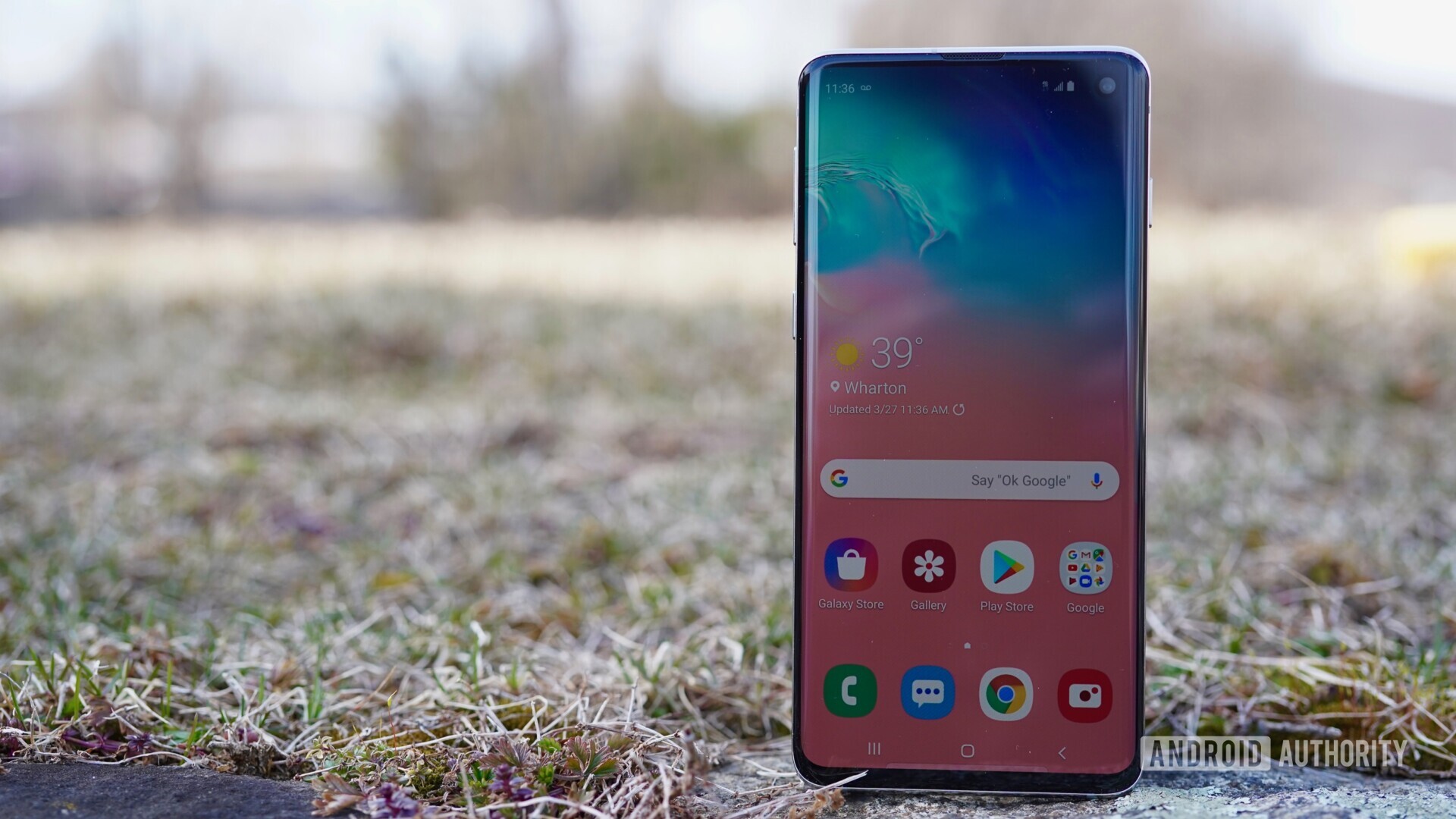
Samsung Galaxy S10 review: The verdict
The Samsung Galaxy S10 is hard to put my finger on. I can imagine people at a carrier store hemming and hawing over the price and feature list when compared to the S10e and the S10 Plus. The good news is that you can’t go wrong with any of the new Samsung phones. All three perform at an exceptional level when compared to competing phones in the market.
The S10’s screen is gorgeous, the battery is sufficient, the hardware is top notch, and the software is the best yet from Samsung. Other pros include the headphone jack, expandable storage, wireless charging, fast radios, and waterproof chassis. As for detractors, I’d list the fingerprint reader, fragile materials, and the high price.
Read also: Samsung Galaxy S10 series gets a big $150 price drop
From my viewpoint, the most critical factor in picking the S10 over either of its brothers is the size. This means you’ll be best served going to a carrier store and holding each of the three in your hand. If you’re the goldilocks type, then perhaps the S10, which is the middle child in this story, is the phone for you.
The Galaxy S10 is available now from Samsung.com, Amazon, B&H, Best Buy, and other retailers. You can see the full list here. The phone is available in Prism White, Prism Black, Prism Blue, or Flamingo Pink.
And that wraps up our Samsung Galaxy S10 review. Will you buy this phone?
Samsung Galaxy S10 in the news
- Samsung One UI 2 with Android 10 hands on
- Samsung Galaxy S10 gets Android 10 beta update
- Samsung Galaxy S10 vs the competition
- Galaxy S10 fingerprint flaw spooks banks
- Here’s how to get Android 10 on Samsung Galaxy S10
- App turns Samsung Galaxy S10 camera cutout into battery status
- Samsung Galaxy S10e, S10, S10 Plus Update Hub: Sprint rolling out night sight
- Fastest charging cables for the Samsung Galaxy S10, S10 Plus
- Samsung Galaxy S10e: Still the best Galaxy for most
- Warning: Recent Samsung Galaxy S10 update locking folks out of their phones